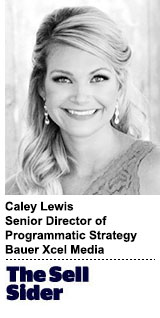 “The Sell Sider” is a column written by the sell side of the digital media community.
“The Sell Sider” is a column written by the sell side of the digital media community.
Today’s column is written by Caley Lewis, senior director of programmatic strategy at Bauer Xcel Media.
The number of brands moving programmatic media buying in-house doubled to 35% in 2017. With brands pushing for more control and transparency, this trend is likely to continue.
For publishers, working directly with brands offers several opportunities to create a closer relationship, but it’s not without risks and costs.
Brands that have taken responsibility for their own media buying are launching a new, complicated phase of their business. A publisher team may jump at the opportunity to enter the RFP process when asked by a big brand, but be warned: The courting process is nothing compared to the marriage itself.
Much like a scene from “The Bachelor,” I’ve gone through round after round of meetings during a selection process to work with a big brand that decided to take media buying in-house. If you are picked to work direct, you might want to start popping the champagne, but you also need to start preparing. We got the red rose in the end, but we also got a mandate to step up our game, big time.
Brands new to automated media buying are just setting up their programmatic data, reporting and execution shop. They’ll likely still rely on their agencies to manage the proposal and media-planning phase and work with a demand-side platform (DSP) to execute their media buys for them. Research shows that only a small percentage of brands fully manage programmatic in-house without some reliance on third parties. This means that publishers aren’t just working with the brand but with a big team of different stakeholders that are all new to the situation.
While agencies have years of experience managing brands’ media buying, publishers are unlikely to be that well-versed. I recommend that publishers use the RFP process as a chance to ask lots of questions and nail down their own strategies for succeeding as a direct partner. Just like picking a mate, it’s important to be honest about what they can really offer while remaining happy with the relationship.
For some publishers, this can be a chance to create a plan for premium quality content or beefing up channels such as social media or native. For other relationships, the strategy might revolve around targeting. Not everyone can do it all.
Whatever the strategy, resources will be required to keep the partnership working, and not just a typical campaign manager or operations and delivery team. If there isn’t an official handoff, the brand often hopes that publishers will be there to fill gaps left by their agency. Publishers may need to rely on editorial staff, the data team and the technology team to make sure they give brands the value they expect in return for a direct relationship. Publishers will need to use their own assets to deliver insights and new data options that the brand could benefit from.
Luckily, many publishers have a lot of great insights and audience data that is underused. As soon as a brand is left with only its first-party assets and not the discounted access to third-party data through its agency, it can be more open to using a publisher’s second-party data. Publishers can often increase earnings with the brand and boost their value by creating custom audience segments and content targeting strategies that they’d normally not be asked to do. It might take more resources, but it can create a more valuable campaign for the buyer and seller.
Once a publisher has aligned its strategy and created an internal approach, it is best to act as a united front. Custom content and publisher insights are great, but they need to fit in with the brand’s point of view, the DSP’s delivery and the agency’s creative and planning.
Rather than rely on a supply-side platform or other vendor partner, publishers need to make sure they are in step with everyone else’s plans and processes. They must be as transparent as possible with the agency and DSP so that there are no hiccups for the brand and no surprises that could hurt delivery. This means that, in addition to being transparent about data, reporting and delivery, publishers will need to meet regularly, in person, not only with the brand but with the DSP and the agency, too.
The brands that take media buying in-house and find that they like the increase in control and transparency will improve their capabilities over time. They’ll hire more delivery and data experts, create a more robust buying strategy and do more of their own analyses.
For the relationship to stay strong, publishers need to grow and change with the brand’s demands. The increase in transparency and resources required can be nerve-wracking, but investing in a good relationship now will ensure a happier marriage in the long run.
Follow Bauer Xcel Media (@bauerxcel) and AdExchanger (@adexchanger) on Twitter.












